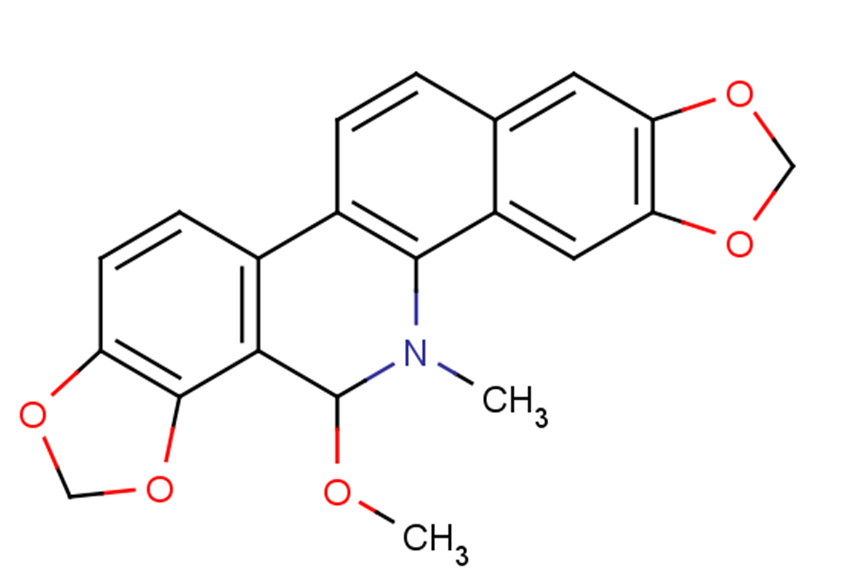
6-Methoxydihydrosanguinarine
CAS No. 72401-54-8
6-Methoxydihydrosanguinarine( —— )
Catalog No. M22599 CAS No. 72401-54-8
6-Methoxydihydrosanguinarine is a natural product. 6-Methoxydihydrosanguinarine shows strong cytotoxicity against MCF-7 and SF-268 cell lines with IC50 values of 0.61 μM and 0.54 μM, respectively.
Purity : >98% (HPLC)
 COA
COA
 Datasheet
Datasheet
 HNMR
HNMR
 HPLC
HPLC
 MSDS
MSDS
 Handing Instructions
Handing Instructions
| Size | Price / USD | Stock | Quantity |
| 5MG | 332 | In Stock |


|
| 10MG | 488 | In Stock |


|
| 25MG | 776 | In Stock |


|
| 50MG | 1044 | In Stock |


|
| 100MG | 1404 | In Stock |


|
| 200MG | Get Quote | In Stock |


|
| 500MG | Get Quote | In Stock |


|
| 1G | Get Quote | In Stock |


|
Biological Information
-
Product Name6-Methoxydihydrosanguinarine
-
NoteResearch use only, not for human use.
-
Brief Description6-Methoxydihydrosanguinarine is a natural product. 6-Methoxydihydrosanguinarine shows strong cytotoxicity against MCF-7 and SF-268 cell lines with IC50 values of 0.61 μM and 0.54 μM, respectively.
-
Description6-Methoxydihydrosanguinarine is a natural product. 6-Methoxydihydrosanguinarine shows strong cytotoxicity against MCF-7 and SF-268 cell lines with IC50 values of 0.61 μM and 0.54 μM, respectively.It has antibacterial activity against Methicillin-resistant Staphylococcus aureus (MRSA) strains with minimum inhibitory concentrations (MICs) ranging from1.9 to 3.9 microg/ml6-methoxydihydrosanguinarine (6ME), a benzophenanthridine alkaloid isolated from Hylomecon species, may have potential as a chemotherapeutic agent. 6ME inhibits the growth of HepG2 cells in a concentration- and time-dependent manner (IC50=3.8+/-0.2 microM following 6 h incubation). Treatment of HepG2 cells with 6ME resulted in the release of mitochondrial cytochrome c followed by the activation of caspase proteases, and subsequent proteolytic cleavage of poly(ADP-ribose) polymerase. 6ME increased the expression of p53 and bax and decreased the expression of bcl-2. The cytotoxic effect of 6ME is mediated by the time-dependent generation of reactive oxygen species. Preincubation of HepG2 cells with vitamin C decreased the expression of p53 and bax and inhibited the release of cytochrome c, activation of downstream caspase and the cleavage of poly(ADP-ribose) polymerase, thus inhibiting the apoptosis inducing effect of 6ME.
-
In Vitro——
-
In Vivo——
-
Synonyms——
-
PathwayOthers
-
TargetOther Targets
-
RecptorOthers
-
Research Area——
-
Indication——
Chemical Information
-
CAS Number72401-54-8
-
Formula Weight363.36
-
Molecular FormulaC21H17NO5
-
Purity>98% (HPLC)
-
SolubilityIn Vitro:?DMSO : 12.5 mg/mL (34.40 mM)
-
SMILESCOC1N(C)c2c(ccc3cc4OCOc4cc23)-c2ccc3OCOc3c12
-
Chemical Name——
Shipping & Storage Information
-
Storage(-20℃)
-
ShippingWith Ice Pack
-
Stability≥ 2 years
Reference
1. Yin H Q , Kim Y H , Moon C K , et al. Reactive oxygen species-mediated induction of apoptosis by a plant alkaloid 6-methoxydihydrosanguinarine in HepG2 cells[J]. Biochemical Pharmacology, 2005, 70(2):242-248.
molnova catalog



related products
-
2,4-Difluorobenzalde...
2,4-Difluorobenzaldehyde target bont - botulinum neurotoxin type A (Clostridium botulinum).
-
Erythro-Guaiacylglyc...
Erythro-Guaiacylglycerol-beta-coniferyl aldehyde ether,cytotoxic effects on human cancer cell lines
-
β-Casomorphin (1-5),...
β-Casomorphin (1-5), amide, bovine is a peptide of bovine β-Casomorphin.



 Cart
Cart
 sales@molnova.com
sales@molnova.com


